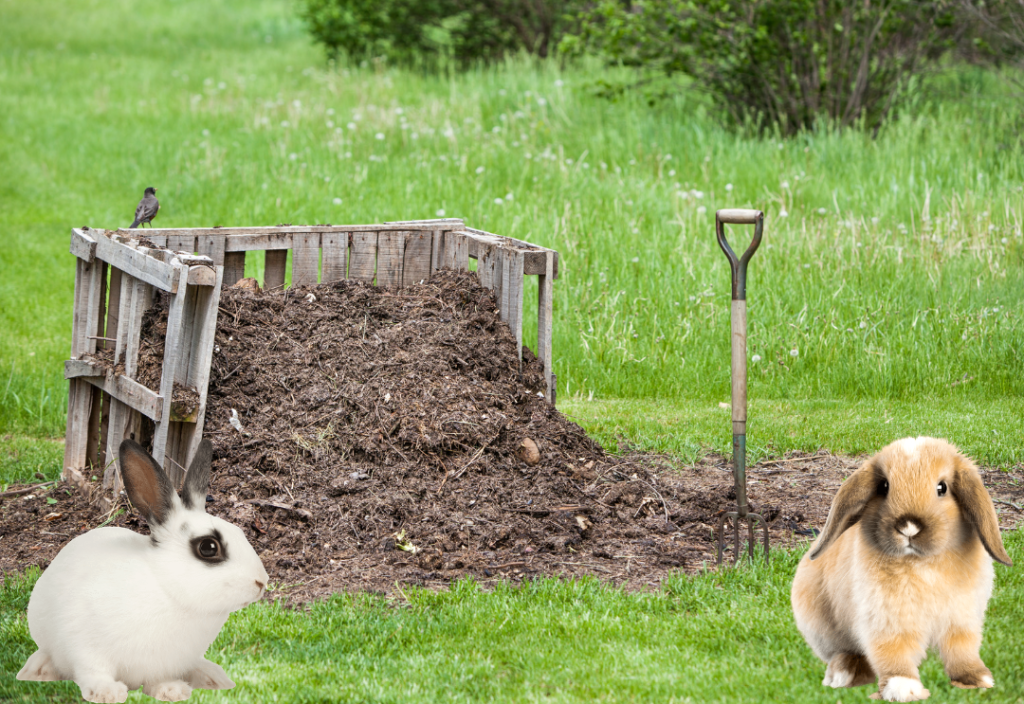Disclosure: We may earn money or products from the companies mentioned in this post.
Composting is an excellent way to turn rabbit manure into a rich, organic fertilizer that can be used to nourish your garden or farm. In this article, we’ll provide a step-by-step guide to composting rabbit manure, as well as answer some common questions about the process.

Step-by-Step Guide to Composting Rabbit Manure:
Step 1: Collect the manure. Start by collecting the rabbit manure and any bedding or litter that is mixed in with it. If you have a large amount of manure, you may want to consider using a pitchfork or shovel to make the process more efficient.
Step 2: Add a carbon source. To help balance the nitrogen-rich manure, you’ll need to add a carbon source such as dried leaves, straw, or shredded paper. Aim for a ratio of roughly two parts carbon to one part manure.
Step 3: Mix the materials. Thoroughly mix the manure and carbon source together using a garden fork or shovel. Make sure that the materials are well-blended and evenly distributed.
Step 4: Monitor moisture levels. Your compost pile should be damp, but not too wet. If the pile is too dry, add water using a watering can or hose. If it’s too wet, add more carbon-rich material.
Step 5: Turn the pile. Every few days, use a garden fork or compost turner to mix the materials and aerate the pile. This will help speed up the composting process and ensure that all of the materials are evenly broken down.
Step 6: Wait for composting to complete. Rabbit manure typically takes between two and six months to fully compost, depending on the size of the pile and the environmental conditions. You’ll know that the compost is ready when it is dark, crumbly, and smells earthy.
FAQ About Composting Rabbit Manure For Garden Fertilizer
How much composted rabbit manure should I use in my garden?
The amount of composted rabbit manure that should be used in the garden can depend on a few factors, such as the soil type, the plant species being grown, and the condition of the soil. As a general rule of thumb, a good starting point is to apply 1-2 inches of composted rabbit manure to the soil surface and work it into the top 4-6 inches of soil. This can be done prior to planting or during the growing season as a top dressing.
For heavy feeders such as tomatoes, cucumbers, and corn, a higher application rate may be needed. In these cases, up to 4-6 inches of composted rabbit manure can be applied to the soil surface and worked into the top 8-10 inches of soil. For plants that are more sensitive to high nutrient levels, such as herbs or fruit trees, a lower application rate of 1 inch or less may be more appropriate.
It’s important to note that while composted rabbit manure is a valuable soil amendment, it should not be the sole source of nutrients for plants. It is recommended to also use other organic fertilizers and amendments, such as bone meal, blood meal, or seaweed, to provide a balanced mix of nutrients to the soil. By combining composted rabbit manure with other organic fertilizers, gardeners can improve soil health and promote healthy plant growth.
Can rabbit manure be composted alone?
Rabbit manure can be composted alone, but it may be beneficial to mix it with other organic materials such as leaves, straw, or kitchen scraps. This will help balance the nutrient content of the compost and ensure that the pile breaks down more evenly.
How long does rabbit manure need to be composted?
Rabbit manure typically takes between two and six months to fully compost, depending on a variety of factors including the size of the pile, the environmental conditions, and the composting method used.
What specific pathogens can uncomposted rabbit manure have?
Uncomposted rabbit manure may contain a variety of pathogens that can be harmful to humans, animals, and plants. Some of the specific pathogens that may be present include E. coli, Salmonella, and various strains of bacteria and viruses. Composting the manure can help break down these pathogens and reduce the risk of contamination.
Is composted rabbit manure safe for humans?
Composted rabbit manure is generally considered safe for humans to use in gardening and agriculture. The composting process helps break down any potential pathogens that may be present in the manure, reducing the risk of contamination.
However, it is still important to handle the compost carefully and practice good hygiene, such as wearing gloves and washing hands after working with the compost. Additionally, it is important to use composted rabbit manure, as uncomposted manure may contain higher levels of pathogens that could pose a health risk.
Are there any special considerations for composting rabbit manure in cold climates?
mposting rabbit manure in cold climates can be more challenging than in warmer regions, as the colder temperatures can slow down the composting process. However, with the right approach, it is still possible to compost rabbit manure in cold climates.
Here are some tips for composting rabbit manure in cold climates:
- Use a larger compost pile: A larger pile can generate more heat, which can help to keep the composting process going even in colder temperatures.
- Use an insulated bin: Using an insulated bin or container can help to retain heat and keep the composting process going even in colder weather.
- Add more carbon-rich material: In cold weather, the compost pile may need more carbon-rich materials (such as straw or leaves) to help balance the high nitrogen content of the rabbit manure and maintain a healthy composting process.
- Cover the compost pile: Covering the compost pile can help to retain heat and moisture, which can speed up the composting process.
- Use a compost thermometer: A compost thermometer can help to monitor the temperature of the compost pile and ensure that it stays within the optimal range for composting.
- Be patient: Composting in cold weather may take longer than in warmer weather. It is important to be patient and continue to add new material to the compost pile, even if it takes longer to break down.
By following these tips, it is possible to successfully compost rabbit manure even in cold climates.
In conclusion, composting rabbit manure is a simple and effective way to turn a waste product into a valuable resource for your garden or farm. By following these simple steps and monitoring your compost pile regularly, you can create a rich, nutrient-dense fertilizer that will help your plants thrive.
